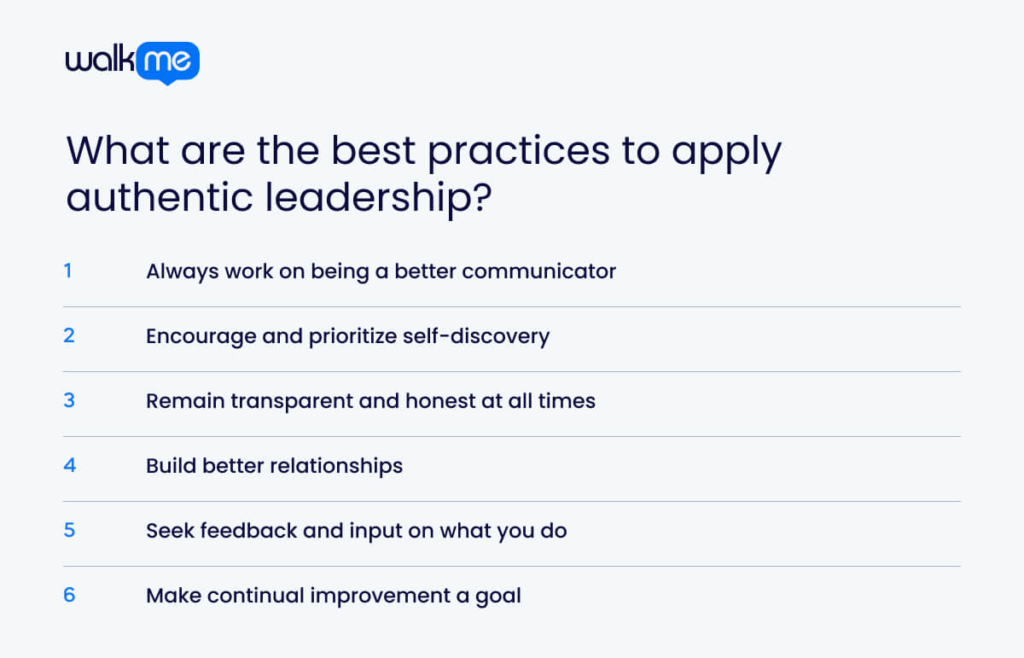New leaders often think they must appear strong, have all the answers, and never show weakness. But employees usually want the opposite.
Traditional leadership focuses on goals and values profit and employee productivity. However, authentic leadership focuses on purpose and prioritizes inclusivity, ethics, and morals.
It creates a culture of honesty and transparency. In this type of organizational culture, all employees feel heard and empowered.
This article explains authentic leadership and shows how it differs from other styles. It includes examples, best practices, and key traits of authentic leaders.
What is authentic leadership?
Authentic leadership is a leadership style where leaders act with integrity, honesty, and transparency, staying true to their values. They make decisions based on principles rather than short-term gains and take full responsibility for their actions.
By relying on their core values to guide them, authentic leaders build trust with employees, peers, and stakeholders. This approach fosters a positive work environment and improves an organization’s performance.
What sets authentic leadership apart is the motivation behind it. An authentic leader aims to build meaningful relationships with their team. They work toward the organization’s mission, not just profit. People want leaders they can connect with and relate to. They seek leaders who understand them but are also a bit more experienced.
How is authentic leadership different from other leadership styles?
The goal of authentic leadership is to build trust and commitment over time. Authentic leaders focus on being genuine, self-aware, and leading with integrity. They prioritize openness, transparency, and ethical decision-making. They inspire others through their values and actions rather than just using authority.
Here are the differences with other leadership styles:
Servant leadership
Servant leadership is about putting the team’s needs first. These leaders focus on empowering and supporting their team. Unlike authentic leaders, servant leaders focus more on others’ growth than their own. They believe serving the team helps the entire organization.
Transformational leadership
Transformational leadership is about driving change and motivating people to support a bigger vision. The main goal isn’t building relationships but inspiring followers to accept change. Transformational leaders encourage their teams to think beyond their current roles. They focus on long-term goals and aim to transform their organization.
Transactional leadership
Transactional leadership focuses on short-term tasks and clear rewards or punishments. It doesn’t prioritize trust or relationships. Instead, employees follow rules to meet specific goals in exchange for rewards. There is little focus on personal growth or motivation. The leader aims to achieve immediate results through clear roles and expectations.
What are the main traits of authentic leaders?

The most important traits of authentic leaders are:
Dedicated to building relationships
Authentic leaders build strong relationships with employees. Employees respond better to managers who truly care about them. When workers feel supported, they become more invested in their jobs.
Authentic leaders try to understand their feelings. Leading with heart means being more human. For example, If someone needs to leave due to a family emergency, the manager can show concern.
Honesty
Honesty is crucial in authentic leadership. Leaders must be honest about themselves and others. This includes sharing their struggles and being clear about others’ performances. Authentic leaders understand that real change requires explaining the reasons behind their plans.
They must be open to competition, market opportunities, and challenges. Leaders should present information clearly and avoid sugarcoating it.
Self-awareness
Authentic leaders understand themselves well. They know their strengths and weaknesses. They also recognize their limits. They often have high emotional intelligence. This skill is important for being a successful leader.
An effective leader is also self-aware. They pay attention to how others see their words and notice how others view their actions.
Have better control of their emotions
Being in control of their emotions helps authentic leaders stay focused. You want a leader who remains calm during stressful times. When employees see this, they feel more confident and relaxed, and it helps them manage their own feelings.
When stress happens, an authentic leader stays calm and changes the plan. This encourages the team to keep working toward the goal.
Takes the initiative
Authentic leaders take the lead. They don’t ask others to do what they won’t do themselves. Instead, they show the way.
These leaders know that being transparent first helps create trust. This makes employees feel safe and confident, and it also encourages them to share their problems or concerns with you.
Accountability
Not all leaders are good at owning up to their mistakes. Authentic leaders understand that to build trust, they must take responsibility for their actions. Being accountable helps leaders reach their goals and become better. They understand that everyone makes mistakes. A strong leader has a strong moral compass and takes responsibility for their shortcomings.
What are some examples of authentic leaders?
Here are some examples of authentic leaders:
Jacinda Arden
New Zealand Prime Minister Jacinda Ardern was an authentic leader during the Covid pandemic. Her government controlled the virus effectively. They quickly enforced a strict lockdown to reduce its spread.
Ardern also showed empathy throughout her leadership. She was known for her warmth, kindness, and genuine care for the well-being of New Zealanders.
Warren Buffett
Warren Buffett believed that authentic leaders should admit their mistakes and encourage others to do the same.
His leadership style is clear and straightforward. He avoids complicated language because he knows his industry well and values education. He also believes in enjoying your work and playing to your strengths.
Oprah Winfrey
At first, Oprah was a top daytime talk show host. As these shows became more focused on sensationalism, she chose a different path in 1994.
She started focusing on spirituality and self-improvement. Her public speaking skills were one of her greatest strengths. Through this talent, she helped people affected by tragedies. Since then, she has constantly reinvented herself.
What are the best practices to apply authentic leadership?

The main best practices you can use to apply authentic leadership are:
Always work on being a better communicator
Communication is key for leaders to build trust and show authenticity.
Leaders who share stories are more engaging. Your stories can shape your organization’s culture. Be clear about your message. Each conversation is a chance to share your ideas and values. Balance detail and simplicity.
Networking is about building relationships, not just collecting business cards. Create a network diagram to identify who can help you. Rank your connections and find gaps to learn from others.
People listen better to a pleasant tone. Pay attention to your voice and avoid rushing through your speech. Use inclusive language like ‘we’ and ‘us’ to inspire your listeners.
Encourage and prioritize self-discovery
It’s important to know your strengths, weaknesses, and core values. This is the first step to being authentic. You can’t lead well if you don’t know who you are.
Self-awareness helps you grow as a leader. You also need self-discipline to stay focused on your goals. Authentic leaders don’t give up; they find solutions.
Leaders who focus on their strengths perform better. This builds their confidence, helps them make better decisions, and motivates their team to do better.
When you grow your strengths, you help others grow too. Use your strengths to be a real, supportive leader. The best leaders help their team by using a strengths-based approach. Learn how your team works best. Assign tasks that match their strengths.
Remain transparent and honest at all times
Authentic leaders don’t try to be someone else. They are true to themselves at work. Instead of hiding, they share their stories and experiences. This helps them connect with their team. Their decisions are honest and clear.
They don’t always follow others’ opinions. But they respect different views. To be an authentic leader, you need to be open and honest, even when it’s tough. If something is wrong with a project, encourage your team to speak up. Your employees shouldn’t hide problems. They also shouldn’t face consequences for being honest.
Build better relationships
Building relationships with others helps you grow as an authentic leader. It allows you to understand your team in a personal and professional way.
Start with a daily morning huddle. In these meetings, everyone can share what’s blocking them at work or at home. This helps the team discuss how to support each other and shows everyone’s unique working style.
You can also have weekly one-on-one meetings with each team member. Ask how they are doing, what they enjoyed about their week, and what they disliked.
Leaders aren’t expected to be perfect. Remember, you’re human, too, with emotions and challenges.
Seek feedback and input on what you do
Authentic leaders know they need to understand how others see them. Honest feedback helps them grow. Leaders who want to improve must surround themselves with people who tell the truth.
A feedback loop is when one bit of feedback leads to more. Leaders with empathy and clear values often get more feedback. This helps them keep improving.
Tough feedback can be hard to hear. Use a journal to write down your feelings. Think about why you felt that way. Was there truth in the feedback? If not, maybe one of your values was challenged. If so, which one?
Make continual improvement a goal
Authentic leadership isn’t a goal — it’s a way of living.
Great leaders always grow and learn. Make a leadership development plan and review it often. What do you stand for as a leader? What will you never compromise on, even if it costs you your job?
Write these things down. When your team has different ideas, try to understand why. Think about what the differences mean and why they matter. A mentor can help you with advice and feedback. They can guide you to become the best leader for your team. Find a mentor with experience in your field for career-specific advice.
Acting in the best interests of your employees
Authentic leadership inspires and motivates individuals, teams, and organizations. It focuses on being genuine and true to oneself. These leaders are usually well-liked by their employees.
Workers under authentic leaders tend to be more engaged and satisfied with their jobs. They feel that their leader understands and cares about their success.
To be an authentic leader, reflect on what you care about. Think about how to build real relationships with your team. Share who you are and what motivates you.
Invest time and effort in connecting with your team members. This work can be the key to your success. If you want to improve yourself, your work, or your team, authentic leadership may be the right approach.
FAQs
The four components of authentic leadership are relational transparency, balanced processing, self-awareness, and a moral perspective.
The core of authentic leadership is knowing your strengths and improving them. Begin by understanding who you are, including your values and goals.

